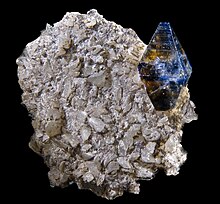| Anatase | |
|---|---|
 | |
| General | |
| Category | Oxide minerals |
| Formula (repeating unit) | TiO2 |
| IMA symbol | Ant[1] |
| Strunz classification | 4.DD.05 |
| Crystal system | Tetragonal |
| Crystal class | Ditetragonal dipyramidal (4/mmm) H-M symbol: (4/m 2/m 2/m) |
| Space group | I41/amd |
| Unit cell | a = 3.7845, c = 9.5143 [Å]; Z = 4 |
| Identification | |
| Formula mass | 79.88 g/mol |
| Color | Black, reddish to yellowish brown, dark blue, gray |
| Crystal habit | Pyramidal (crystals are shaped like pyramids), tabular (form dimensions are thin in one direction). |
| Twinning | Rare on {112} |
| Cleavage | Perfect on [001] and [011] |
| Fracture | Subconchoidal |
| Tenacity | Brittle |
| Mohs scale hardness | 5.5–6 |
| Luster | Adamantine to splendent, metallic |
| Streak | Pale yellowish white |
| Diaphaneity | Transparent to nearly opaque |
| Specific gravity | 3.79–3.97 |
| Optical properties | Uniaxial (−), anomalously biaxial in deeply colored crystals |
| Refractive index | nω = 2.561, nε = 2.488 |
| Birefringence | δ = 0.073 |
| Pleochroism | Weak |
| References | [2][3][4] |
Anatase is a metastable mineral form of titanium dioxide (TiO2) with a tetragonal crystal structure. Although colorless or white when pure, anatase in nature is usually a black solid due to impurities. Three other polymorphs (or mineral forms) of titanium dioxide are known to occur naturally: brookite, akaogiite, and rutile, with rutile being the most common and most stable of the bunch. Anatase is formed at relatively low temperatures and found in minor concentrations in igneous and metamorphic rocks.[5] Glass coated with a thin film of TiO2 shows antifogging and self-cleaning properties under ultraviolet radiation.[6]
Anatase is always found as small, isolated, and sharply developed crystals, and like rutile, it crystallizes in a tetragonal system. Anatase is metastable at all temperatures and pressures, with rutile being the equilibrium polymorph. Nevertheless, anatase is often the first titanium dioxide phase to form in many processes due to its lower surface energy, with a transformation to rutile taking place at elevated temperatures.[7] Although the degree of symmetry is the same for both anatase and rutile phases, there is no relation between the interfacial angles of the two minerals, except in the prism-zone of 45° and 90°. The common octahedral crystal habit of anatase, with four perfect cleavage planes, has an angle over its polar edge of 82°9', whereas rutile octahedra only has a polar edge angle of 56°52½'. The steeper angle gives anatase crystals a longer vertical axis and skinnier appearance than rutile. Additional important differences exist between the physical characters of anatase and rutile. For example, anatase is less hard (5.5–6 vs. 6–6.5 on the Mohs scale) and less dense (specific gravity about 3.9 vs. 4.2) than rutile. Anatase is also optically negative, whereas rutile is optically positive. Anatase has a more strongly adamantine or metallic-adamantine luster than that of rutile as well.[8]
- ^ Warr, L.N. (2021). "IMA–CNMNC approved mineral symbols". Mineralogical Magazine. 85 (3): 291–320. Bibcode:2021MinM...85..291W. doi:10.1180/mgm.2021.43. S2CID 235729616.
- ^ "Anatase" (PDF). Handbook of Mineralogy – via geo.arizona.edu.
- ^ "Anatase". Mindat.org.
- ^ "Anatase". Webmineral.com. Retrieved 2009-06-06.
- ^ Page 419 Deer, Howie and Zussman "An Introduction to the Rock Forming Minerals" ISBN 0 582 44210 9
- ^ Wang, Rong; Hashimoto, Kazuhito; Fujishima, Akira; Chikuni, Makota; Kojima, Eiichi; Kitamura, Atsushi; Shimohigoshi, Mitsuhide; Watanabe, Toshiya (July 1997). "Light-induced amphiphilic surfaces". Nature. 388 (6641): 431–432. Bibcode:1997Natur.388..431W. doi:10.1038/41233. S2CID 4417645.
- ^ Hanaor, Dorian A. H.; Sorrell, Charles C. (2011). "Review of the anatase to rutile phase transformation". Journal of Materials Science. 46 (4): 855–874. Bibcode:2011JMatS..46..855H. doi:10.1007/s10853-010-5113-0. S2CID 97190202.
- ^ One or more of the preceding sentences incorporates text from a publication now in the public domain: Spencer, Leonard James (1911). "Anatase". In Chisholm, Hugh (ed.). Encyclopædia Britannica. Vol. 1 (11th ed.). Cambridge University Press. pp. 919–920.